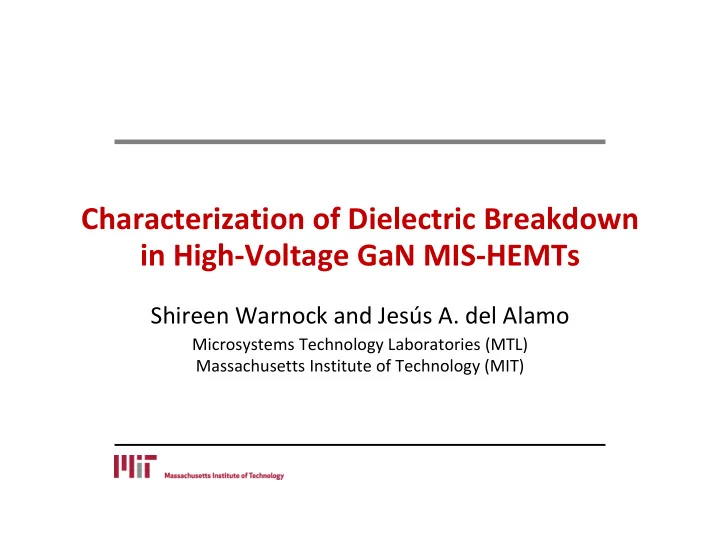

Characterization of Dielectric Breakdown in High‐Voltage GaN MIS‐HEMTs Shireen Warnock and Jesús A. del Alamo Microsystems Technology Laboratories (MTL) Massachusetts Institute of Technology (MIT)
Outline • Motivation & Challenges • Time‐Dependent Dielectric Breakdown (TDDB) Experiments: ‒Current‐Voltage ‒Capacitance‐Voltage • Progressive Breakdown • Conclusions 2
Motivation GaN Field‐Effect Transistors (FETs) promising for high‐voltage power applications more efficient & smaller footprint 3
GaN Reliability Challenges Inverse piezoelectric effect J. A. del Alamo, MR 2009 4
GaN Reliability Challenges Inverse piezoelectric effect J. A. del Alamo, MR 2009 Current collapse D. Jin, IEDM 2013 5
GaN Reliability Challenges Inverse piezoelectric effect J. A. del Alamo, MR 2009 Current collapse D. Jin, IEDM 2013 V T instability 6
GaN Reliability Challenges Inverse piezoelectric effect J. A. del Alamo, MR 2009 Current collapse D. Jin, IEDM 2013 Gate oxide reliability V T instability 7
Time‐Dependent Dielectric Breakdown • High gate bias → defect genera�on → catastrophic oxide breakdown • Often dictates lifetime of chip Gate material melted after Typical TDDB experiments: breakdown Si high‐k MOSFETs T. Kauerauf, EDL 2005 D. R. Wolters, Philips J. Res. 1985 8
Dielectric Reliability in GaN FETs AlGaN/GaN metal‐insulator‐semiconductor high electron mobility transistors (MIS‐HEMTs) Very little currently known about TDDB in GaN goal of this work 9
TDDB Experiments: Current‐Voltage 10
GaN MIS‐HEMTs for TDDB study • GaN MIS‐HEMTs from industry collaboration: depletion‐mode • Gate stack has multiple layers & interfaces → Uncertain electric field distribution → Many trapping sites stress time ↑ • Complex dynamics involved → Unstable and fast changing V T P. Lagger, TED 2014 11
Classic TDDB Experiment Constant gate voltage stress experiment: Hard breakdown I G SILC trapping t BD S. Warnock, CS MANTECH 2015 Experiment gives time to breakdown and shows generation of stress‐induced leakage current (SILC) 12
GaN TDDB Statistics Examine statistics for different V Gstress • Weibull distribution • As V Gstress ↑, t BD ↓ • Parallel statistics consistent with results in silicon 13
TDDB with Periodic Characterization Pause TDDB stress and sweep transfer characteristics at V DS =0.1 V V DS =0.1 V • Large V T shi� → trapping in dielectric or AlGaN • Immediate S degrada�on → interface state generation early in experiment 14
Validity of Characterization Approach Compare statistics for standard and interrupted schemes Same sta�s�cs for both schemes → characteriza�on is benign 15
Step‐Stress TDDB • Step‐stress to examine early stages of degradation • Step V Gstress in 0.5 V increments until breakdown V DS =0 V • Low V Gstress : I G ↓ ⇒ trapping • High V Gstress : I G ↑ ⇒ SILC 16
Step‐Stress TDDB Transfer characteristics in between stress steps V DS =0.1 V • S and V T degradation is progressive • At V Gstress 12.5 V, ΔV T < 0 (red lines) ‒ Sudden increase in S, appearance of SILC→ interface state generation 17
TDDB Experiments: Capacitance‐Voltage 18
C‐V Characterization • At V GS >1 V, conduction band of AlGaN starts being populated 19
C‐V Characterization TDDB characterization takes place here • TDDB characterized in regime where AlGaN is populated with electrons 20
Constant V Gstress TDDB C GG vs. stress time in 5 devices at 5 different frequencies: • As stress �me ↑ → C GG ↑ → Frequency dispersion ↑ • Consistent with trap creation and trapping ‒ In dielectric and/or at MIS interface 21
Progressive Breakdown 22
Observation of Progressive Breakdown Revisit classic TDDB experiment: V Gstress =12.6 V, V DS =0 V hard breakdown (HBD) trapping SILC 23
Observation of Progressive Breakdown Revisit classic TDDB experiment: V Gstress =12.6 V, V DS =0 V Near breakdown, I G becomes noisy progressive breakdown (PBD) 24
Observation of Progressive Breakdown Revisit classic TDDB experiment: V Gstress =12.6 V, V DS =0 V t HBD t PBD Near breakdown, I G becomes noisy progressive breakdown (PBD) 25
PBD Statistics Compare statistics for t PBD and t HBD PBD HBD V Gstress =12.3 V V DS,stress =0 V Statistics nearly parallel breakdown mechanism is same 26
PBD Statistics • Examine PBD and HBD times for each individual device • PBD and HBD in same device linked by a line PBD HBD V Gstress =12.3 V V DS,stress =0 V S. Warnock, IRPS 2016 HBD, PBD uncorrelated from device to device dielectric defect generation is truly random 27
Conclusions • Developed methodology to study TDDB in GaN MIS‐ HEMTs • TDDB behavior consistent with Si MOSFETs: ‒ Weibull distribution ‒ SILC before breakdown ‒ Clear observation of Progressive Breakdown • For moderate gate voltage stress: ‒ ΔV T > 0 ‒ I G ↓ • Beyond critical value of V Gstress : ‒ ΔV T < 0 ‒ Sudden ΔS ↑ ‒ Capacitance frequency dispersion ↑ 28
Conclusions • Developed methodology to study TDDB in GaN MIS‐ HEMTs • TDDB behavior consistent with Si MOSFETs: ‒ Weibull distribution ‒ SILC before breakdown ‒ Clear observation of Progressive Breakdown • For moderate gate voltage stress: ‒ ΔV T > 0 Consistent with electron trapping ‒ I G ↓ • Beyond critical value of V Gstress : ‒ ΔV T < 0 ‒ Sudden ΔS ↑ ‒ Capacitance frequency dispersion ↑ 29
Conclusions • Developed methodology to study TDDB in GaN MIS‐ HEMTs • TDDB behavior consistent with Si MOSFETs: ‒ Weibull distribution ‒ SILC before breakdown ‒ Clear observation of Progressive Breakdown • For moderate gate voltage stress: ‒ ΔV T > 0 Consistent with electron trapping ‒ I G ↓ • Beyond critical value of V Gstress : Onset of trap generation ‒ ΔV T < 0 in dielectric/at MIS ‒ Sudden ΔS ↑ interface ‒ Capacitance frequency dispersion ↑ 30
Acknowledgements 31
Questions? 32
Recommend
More recommend